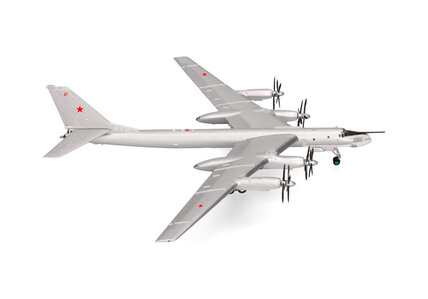Following the end of World War II and amongst rising tensions between the United States and the Soviet Union, the Soviet Air Forces’ Long-Range Aviation was in need of a strategic bomber that could fly at high speeds and achieve intercontinental ranges. Despite initial preference for the jet-powered Myasischchev M-4, focus shifted in favor of the Tupolev Design Bureau’s "Aircraft 95" project, after the M-4 fell short of its planned capabilities. Powered by four 12,000 hp turboprop engines, each fitted with two contra-rotating propellers and allowing speeds of well over 800 kilometers per hour, the prototype’s first flight took place on November 12, 1952. The first production aircraft was handed over to the first of three Heavy Bomber Aviation Divisions in 1956. A complete redesign took place in the 1970s, resulting in the TU-95MS version. It featured new wings of greater surface as well as a stretched fuselage to accommodate up to six cruise missiles on an internal rotary launcher. A striking feature was the addition of a new target illumination / guidance radar in a "duck bill" radome. The improved Kuznetsov NK-12 turboprop engines now delivered up to 15,000 hp, allowing a maximum range of 15,000 km (9,300 mi) without refueling. Production of the TU-95MS commenced in 1981. The 1023rd and 1226th Regiments of the 79th Heavy Bomber Aviation, based at Chagan Air Base near Semipalatinsk in what was then the Kazakh Soviet Socialist Republic, were the first to reequip with the modernized version of the TU-95 starting from 1983. In total, 88 aircraft were delivered by 1992.
Scale:
1:200
Dimensions: see
this page
Material: mainly metal
Brand: Herpa Wings

Nr: 573832
In stock:
future release, release date unknown
Added to website: 2025-11-13
Brochure / announcement:
January - February 2026






